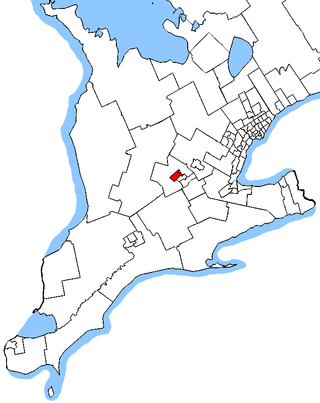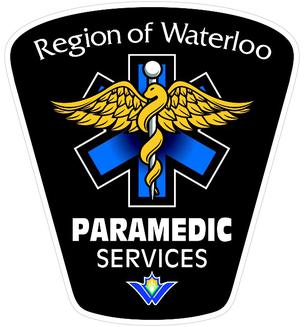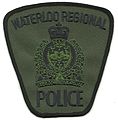
Waterloo is a city in the Canadian province of Ontario. It is one of three cities in the Regional Municipality of Waterloo. Waterloo is situated about 94 km (58 mi) west-southwest of Toronto, but it is not considered to be part of the Greater Toronto Area (GTA). Due to the close proximity of the city of Kitchener to Waterloo, the two together are often referred to as "Kitchener–Waterloo", "K-W", or "The Twin Cities".

Cambridge is a city in the Regional Municipality of Waterloo, Ontario, Canada, located at the confluence of the Grand and Speed rivers. The city had a population of 138,479 as of the 2021 census. Along with Kitchener and Waterloo, Cambridge is one of the three core cities of Canada's tenth-largest metropolitan area.

The Regional Municipality of Waterloo is a metropolitan area of Southern Ontario, Canada. It contains the cities of Cambridge, Kitchener and Waterloo, and the townships of North Dumfries, Wellesley, Wilmot and Woolwich. Kitchener, the largest city, is the seat of government.

The Township of Woolwich is a rural township in Southwestern Ontario, Canada, considered as a municipality. The Township is located in the northeast part of Waterloo Region and is made up of 10 small communities, with Elmira, Ontario the largest and St. Jacobs, Ontario the second largest. The population at the time of the 2021 Census was 26,999, up from the 2016 population of 25,006. Waterloo Region is still home to the largest population of Old Order Mennonites in Canada, particularly in the areas around St Jacobs and Elmira. They are often seen on the local roads using their traditional horse and buggy transportation; many also use horses to pull the implements in their farm fields.

Waterloo County was a county in Canada West in the United Province of Canada from 1853 until 1867, then in the Canadian province of Ontario from 1867 until 1973. It was the direct predecessor of the Regional Municipality of Waterloo.

The Township of Wellesley is the rural, north-western township of the Regional Municipality of Waterloo in Ontario, Canada. It encompasses 277.79 km2 (107.26 sq mi) and had a population of 11,260 in the Canada 2016 Census.

Kitchener—Conestoga is a federal electoral district in Ontario, Canada, that has been represented in the House of Commons of Canada since 2004. Its population in 2021 was 107,134. The riding is currently represented by Liberal MP Tim Louis. In the 2019 election, this is one of only two ridings in the country in which the Liberal candidate unseated the Conservative incumbent.
Galt is a community in Cambridge, Ontario, Canada, in the Regional Municipality of Waterloo, Ontario on the Grand River. Prior to 1973, it was an independent city, incorporated in 1915, but amalgamation with the village of Hespeler, the town of Preston and the village of Blair formed the new municipality of Cambridge. Being the largest constituent community in the city, it is commonly seen as the downtown core of Cambridge. The first mayor of Cambridge was Claudette Millar.
Waterloo South was a federal electoral district and a provincial electoral district in Canada.

Waterloo is the name of a federal electoral district in the Waterloo Region of Ontario, Canada, that has been used in the House of Commons of Canada from since 1968. Between 1997 and 2015, the riding was known as Kitchener—Waterloo.

Preston is a community in Cambridge, Ontario, Canada in the Regional Municipality of Waterloo, Ontario. Prior to 1973 it was an independent town, incorporated in 1915, but amalgamation with the town of Hespeler, Ontario, the city of Galt, Ontario and the village of Blair formed the new municipality of Cambridge. Parts of the surrounding townships were also included. No population data is available for the former Preston since the Census reports cover only the full area of Cambridge, though the combined population of the census tracts covering the majority of Preston reported a population of 20,008 as of the 2016 Canada Census. The first mayor of Cambridge was Claudette Millar.
Waterloo Region District School Board is the public school board for the Region of Waterloo in Ontario, Canada. It operates 105 elementary schools, 16 secondary schools, and other facilities, serving more than 64,000 students in the Region of Waterloo. It has approximately 6,800 staff and a budget of $675 million. It is the largest public sector employer in the Region and the second-largest employer overall. In early 2018, the director of education is John Bryant.

Waterloo Catholic District School Board (WCDSB) is a school board serving the Region of Waterloo, Ontario, Canada. It is headquartered in Kitchener, and is currently the eighth-largest Catholic school system in Ontario.

Region of Waterloo Paramedic Services (ROWPS) is the emergency medical service provider for the Regional Municipality of Waterloo. The service provides both advanced and primary care level paramedic services to the cities of Waterloo, Ontario, Cambridge, Ontario and Kitchener, Ontario and the townships of Wilmot, Woolwich, Wellesley and North Dumfries.
This is a list of media in the Regional Municipality of Waterloo, Ontario, including Kitchener, Waterloo, Cambridge and the surrounding area.

Hespeler is a neighbourhood and former town within Cambridge, Ontario, located along the Speed River in the Regional Municipality of Waterloo, Ontario, Canada. In 1973, Hespeler, Preston, Galt, and the hamlet of Blair were amalgamated to form the City of Cambridge. The first mayor of Cambridge was Claudette Millar.
The 2014 Waterloo Region municipal elections were held on October 27, 2014 in the Regional Municipality of Waterloo, Ontario, Canada, to elect Waterloo Regional Council, the mayors and city councils of Cambridge, Kitchener, North Dumfries, Waterloo, Wellesley, Wilmot, and Woolwich, the Waterloo Region District School Board (Public), the Waterloo Catholic District School Board, and the regional members of Conseil Scolaire de District Catholiques Centre-Sud and Conseil Scolaire Viamonde (Public). The election was held in conjunction with the provincewide 2014 municipal elections.
The 2018 Waterloo Region municipal elections were held on October 22, 2018 in the Regional Municipality of Waterloo, Ontario, Canada, to elect Waterloo Regional Council, the mayors and city councils of Cambridge, Kitchener, North Dumfries, Waterloo, Wellesley, Wilmot, and Woolwich, the Waterloo Region District School Board (Public), the Waterloo Catholic District School Board, and the regional members of Conseil Scolaire de District Catholiques Centre-Sud and Conseil Scolaire Viamonde (Public). The election was held in conjunction with the province wide 2018 municipal elections.
The 2022 Waterloo Region municipal elections were held on October 24, 2022, in the Regional Municipality of Waterloo, Ontario, Canada, to elect Waterloo Regional Council, the mayors and city councils of Cambridge, Kitchener, North Dumfries, Waterloo, Wellesley, Wilmot, and Woolwich, the Waterloo Region District School Board (Public), the Waterloo Catholic District School Board, and the regional members of Conseil Scolaire de District Catholiques Centre-Sud and Conseil Scolaire Viamonde (Public). The election will be held in conjunction with the province wide 2022 municipal elections.
Enova Energy Corporation, through its subsidiary Enova Power Corp., is an electric utility and distributor that serves most municipalities in the Regional Municipality of Waterloo in Ontario. It is a municipally-owned corporation with shares held by the municipalities to varying degrees.


















